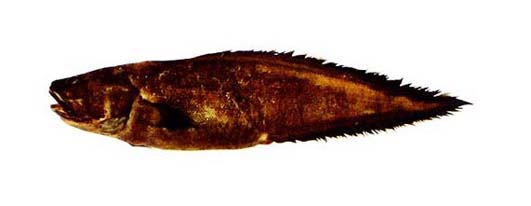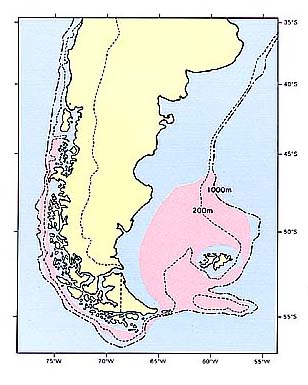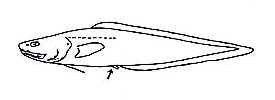フサイタチウオ科

- HOME
- デジタル図鑑
- パタゴニア海域の重要水族
- 硬骨魚綱 アシロ目
- フサイタチウオ科
フサイタチウオ科(Bythitidae)

48
パタゴニアイタチウオ(Patagonia-itachiuo)
Cataetyx messieri (Cünther, 1887)
特 徴:
背鰭約100軟条,臀鰭約70軟条,胸鰭25〜28軟条,胸鰭1軟条,鰓耙数3,鰓条骨数8。頭長は体長の26.0〜27.3%,肉質眼窩径は3.4〜4.2%,体高は17.8〜23.0%,吻長は6.1〜7.4%,両眼間隔は4.6〜5.0%,上顎長は12.7〜14.7%,胸鰭長は14.2〜16.6%,腹鰭長は7.6〜10.2%。体は側扁し延長する。頭は大きく,わずかに縦扁し,体長は頭長の約3.9倍。吻は短くて丸味を帯び,頭長は吻長の約3.5倍。下顎先端に髭はない。眼はやや小さく,頭長は眼径の約7.6倍。鼻孔は1対あり,前鼻孔は上唇上に位置し,後鼻孔は丁度前鼻孔と眼の中間に位置する。口は大きく,上顎後端は眼の後縁下をはるかに越える。上顎には不規則な皮弁と感覚孔が発達する。小感覚孔群が頭部下面にも発達する。鋤骨にV字型の歯帯がある。口蓋骨には1歯帯がある。短くて強い棘が主鰓蓋骨後縁にある。擬鰓がある。数は少ないがよく発達した鰓耙がある。小円鱗が頭部と体部に分布する。短い胸鰭柄がある。腹鰭は1本の糸状鰭条からなり,胸鰭起部下よりわずかに前方に位置する。背鰭起部は体長の前方から約1/3のところに位置する。背鰭基底は長い。臀鰭基底も長いが,背鰭基底よりは短い。肛門付近から交接器と思われる突起物が突出する(たぶん雄の個体と思われるものから)。側線は単線で側線上に乳頭状突起物が並ぶ。体と腹鰭を除く各鰭は全体に暗褐色で,頭部とからだ間部下面と腹鰭は淡褐色。
分 布:
チリ,アルゼンチン,パタゴニア;南アフリカからも知られている(Smith, 1977)。
備 考:
南アフリカ沖では,水深50〜800mから採集されている。今回の調査では300〜600mで漁獲された。
(中村 泉)
Material examined:
6 from Chile (158.0-275.5 mm SL), FAKU CP 211, 951-955.
Description:
D ca. 100; A ca. 70; P1 25-28; P2 1; GR 3; BR 8.
HL 26.0-27.3% of SL; FO 3.4-4.2; BD 17.8-23.0; SN 6.1-7.4; IO 4.6-5.0; UJ 12.7-14.7; P1L 14.2-16.6; P2L 7.6-10.2.
Body elongate and compressed posteriorly with slightly depressed head. Head large, about 3.9 times in SL. Snout short and round, 3.5 times in HL. No barbels on chin. Eye relatively small, 7.6 times in HL. Two nostrils, anterior nostril immediately above dorsal margin of upper lip, posterior nostril midway between anterior nostril and eye. Mouth large, end of maxilla well posterior to posterior margin of eye. Irregular shape of dermal flap and sensory pores along upper jaw. A pair of large sensory pores on chin. Small sensory pores along dentary, angular and ventrally on preopercle. Irregularly sized canine tooth band on both jaws. Palatine teeth in a band. Vomer with V-shaped tooth band. Short, strong spine on posterior end of opercle. Pseudobranchiae absent. Three well developed gill-rakers on lower limb of first arch. Small cycloid scales on body and head. Dorsal and anal fins united to caudal fin. Pectoral fin peduncle short. Pelvic fin with a single filamentous ray, situated slightly anterior to pectoral fin origin. Dorsal fin origin at one-third of body length. Anal papilla of male seems to be a copulatory organ. Single lateral line consists of dotted small papilla running from upper insertion of opercle to caudal peduncle with large interruption above anterior part of anus. Body uniformaly dark brown with ventral parts of head and trunk pale. Pelvic fin pale brown, remaining fins dark brown.
Distribution:
Both Chilean and Argentine Patagonia; also off South Africa (Smith, 1977).
Remarks:
The depth range is about 50-800 m fathoms in South Africa (Smith, 1977).
(Izumi NAKAMURA)

Distribution of Cataetyx messieri in Patagonia.

External feature. Anal papilla arrowed.
- 1